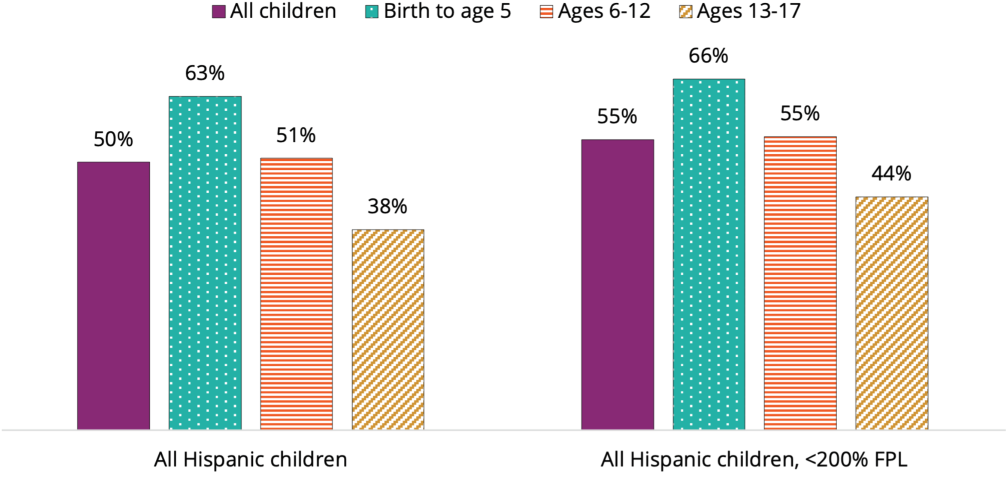Sep 15, 2025
Data Point
Half of Hispanic Children Eat Daily Meals With Their Family
Authors:
Half of all Hispanic children eat at least one meal a day with their family, according to our new analysis of 2022 and 2023 data from the National Survey of Children’s Health. Not surprisingly, preschool-aged children (birth to age 5) are the most likely to have daily family meals (63%). While teenagers are the least likely, nearly 4 in 10 Hispanic children ages 13 to 17 (38%) eat at least one meal a day with their family. Regular family mealtimes have important benefits for children’s physical health, academic skills, well-being, and family relationships.
Figure 1. Half of Hispanic children eat meals with their family every day
Percentage of Hispanic children who eat a meal with their family every day, overall and by age and family income
 Source: Authors’ analysis of the 2022 and 2023 National Survey of Children’s Health.
Source: Authors’ analysis of the 2022 and 2023 National Survey of Children’s Health.Notes: Sample includes Hispanic children under age 18 who are not missing data on family meals. All pairwise differences by age group among all Hispanic children and among those in families with low incomes are statistically significant at p < 0.001.
Relative to all Hispanic children, those in families with low incomes are even more likely (55%) to eat at least one meal a day with their family, regardless of their age: 66 percent of children from birth to age 5 in this income group eat a daily meal with their family, as do 55 percent of children ages 6 to 12 and 44 percent of teens ages 13 to 17. The likelihood of having daily family meals is the same for Hispanic children regardless of whether their parents were born in the United States or in another country, with one exception (see Table A): Among all Hispanic children, teens ages 13 to 17 with only non-U.S.-born parents are more likely to have daily family meals (42%) than those with at least one U.S.-born parent (33%).
A large body of research has documented the benefits of family meals for the health and well-being of children and adolescents. More frequent family meals are linked to better nutritional health among youth, including a healthier diet, a greater likelihood of being in a normal weight range, and a lower likelihood of disordered eating.
The benefits also extend to academic and emotional well-being. For example, among young children, eating more family meals is associated with increased vocabulary and reading skills, which can set youth up for academic success as they enter school. Additionally, more frequent meals during adolescence are associated with a lower risk of alcohol use, violent behavior, and feelings of depression and an increased likelihood of emotional well-being.
Notably, however, the benefits associated with family meals appear to be somewhat stronger for female teens than for their male counterparts, for at least some outcomes. Additionally, family meals seem to have the strongest impact on well-being among youth in families characterized by more positive family dynamics—such as strong parent-child relationships and more limited instances of family arguments.
High-quality family meals can provide parents and caregivers the opportunity to build stronger relationships with their children: During meals, family members can check in and communicate with one another and parents can share important family and cultural values. Regular family meals can also provide structure and stability to home life. However, many families struggle to fit regular family meals into their daily lives. In addition to challenges finding the time to all get together, research with some mothers who have lower incomes highlights that insufficient help preparing meals and/or the need to watch younger children can get in the way of family meals. Many organizations and programs that work with families—including, for example, Head Start—already facilitate families’ access to healthy food and nutrition. Leveraging these varied efforts and sharing strategies to overcome common barriers, such as those available at The Family Dinner Project, can help families make the most of their shared mealtimes.
Methods
For this analysis, we used data from the 2022 and 2023 National Survey of Children’s Health (NSCH), obtained via the Child and Adolescent Health Measurement Initiative’s (CAMHI) Data Resource Center for Child and Adolescent Health (DRC). The NSCH, conducted by the U.S. Census Bureau, is a household survey that provides nationally representative data on the health of children from birth to age 17 in the United States. We define Hispanic children as those for whom a Hispanic, Latino, or Spanish origin was reported, regardless of race. Our analytic sample includes Hispanic children for whom data on eating family meals together are not missing (n=453—or 2.7% of the sample—were missing data on family meals), resulting in an unweighted sample of 16,087 Hispanic children, including approximately 7,210 Hispanic children in families with low incomes.
Our measure of family meals is a dichotomous variable that distinguishes between Hispanic children in families who reported eating a meal together every day in the past week and those who did not. We created the category of families with low incomes (<200% of the federal poverty threshold) using the imputed family poverty variable, which is calculated as the ratio of total family income to the family poverty threshold.1 See the NSCH technical documentation for additional information. For Hispanic children who live with at least one parent (n=15,663),2 we also show estimates according to whether children’s coresidential parents were born in the United States using two categories: 1) all parents in the household were born in another country and 2) at least one parent in the household was born in the United States. For children with only one parent in the household, country of birth was assigned based on that parent alone.
We used survey-adjusted Wald t-tests to assess pairwise differences by age group and parental county of birth category, applying a Benjamini–Hochberg correction to adjust for multiple comparisons.
Table A. Percentage of Hispanic children who eat a meal with their family every day, by age, family income, and parental country of birth
 Source: Authors’ analysis of the 2022 and 2023 National Survey of Children’s Health.
Source: Authors’ analysis of the 2022 and 2023 National Survey of Children’s Health.Notes: Sample includes Hispanic children under age 18 who are not missing data on family meals. Analysis by parental country of birth excludes children not living with at least one parent.
a All pairwise differences by age group within each column are statistically significant (p < 0.001).
b The difference by parental country of birth is statistically significant for children aged 13-17 years (p=0.001).
Suggested Citation
Wildsmith, E. & Maxfield, E.T. (2025). Half of Hispanic children eat daily meals with their family. National Research Center on Hispanic Children & Families. DOI: https://doi.org/10.59377/319w4113k
Footnotes
1Income data are multiply imputed in the NSCH. Per the approach used in the CAMHI DRC, we report the unweighted sample size from the first implicate only. Note that analyses were completed with the full multiply imputed data.
2 Including biological parents, adoptive parents, and step-parents.




